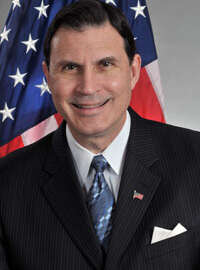 Exclusive
Exclusive Hubbard Radio Washington DC, LLC. All rights reserved. This website is not intended for users located within the European Economic Area.
Hubbard Radio Washington DC, LLC. All rights reserved. This website is not intended for users located within the European Economic Area.
OMB issued the instructions for how agencies can apply for the central fund to move off legacy systems.
The White House remains hopeful that the appropriators will heed its request and open up its wallet to fund the Technology Modernization Fund.
The Trump administration asked for $228 million for fiscal 2018 for a central fund to help push IT modernization projects over the top. That sliver of hope remains because of the copious number of continuing resolutions that are piling up.
Nowhere is that optimism more apparent than in the Office of Management and Budget’s new memo detailing how agencies should apply for that central fund, and the interagency board will oversee those proposals, and how the agency-wide working capital fund (WCF) will work. Both were authorized in the Modernizing Government Technology (MGT) Act, passed by Congress as part of the 2018 Defense authorization bill.
“A thoughtful IT modernization strategy prioritizes projects based on impact and probability of success. Impact can be measured by effect on users, risk reduction, opportunity enablement, and common solutions. Probability of success can be measured by team and project strategy strength,” OMB Director Mick Mulvaney writes in the Feb. 27 memo. “Agencies submitting Initial Project Proposals are encouraged (though not required) to address these considerations, including citing or attaching evidence that their project meets any applicable considerations. Agency project sponsors should also be able to address these issues as part of the evaluation process, should a project merit additional examination by the board.”
The real meat of the MGT Act is the individual working capital funds each agency can set up to “bank” money to put toward future modernization efforts.
Agencies have until March 27 to tell OMB whether they will set up internal working capital funds. If they decide not to immediately but later on choose to, they have to give OMB 30-days notice.
Meanwhile, OMB set up the interagency board on March 1 that will review agency proposals.
Suzette Kent, the Federal CIO, will be the chairwoman of the board. It will also include Alan Thomas, the commissioner of the Federal Acquisition Service at the General Service Administration; Mark Knidienger, director of the Federal Network Resilience division in the Department of Homeland Security; Matt Cutts, acting administrator of the U.S. Digital Service; Rajive Mathur, the Social Security Administration’s CIO; Maria Roat, the Small Business Administration’s CIO; and Charles Worthington, the chief technology officer at the Department of Veterans Affairs.
Former federal IT executives praised OMB for writing fairly clear and straight forward guidelines.
At the same time, these experienced CIOs and technology experts say there are several things agencies should keep in mind as they start to go down this path.
“I’m pleased how they are hitting the ground running with the quick issuance of the guidance that gives a detailed roadmap. It shows the level of commitment and seriousness of OMB to make the MGT Act a useful and viable tool,” said Rich Beutel, president of Cyrrus Analytics and a former House staff member, who helped shepherd the Federal IT Acquisition Reform (FITARA) Act into law. “I hope CIO will leverage the MGT Act fully and to their advantage. Those who pooh-pooh the MGT Act are doing a disservice to their agency and should give it a chance. This isn’t going to happen overnight, especially the working capital funds. They will take two years before they can populate those WCFs with enough money.”
Beutel said the key to the WCFs is ensuring agencies have the broad operational flexibility needed to deploy the funds saved or found to modernize IT.
And that operational flexibility is even more important when you consider how long modernization efforts can take.
John Owens, the former CIO at the U.S. Patent and Trademark Office and now vice president of solution development group at CGI, said he worked for a decade in government and left his replacement with plenty of work to do.
Additionally, he said because agencies are not good at forecasting savings three-or-five years down the road, coming up with money to replace major systems more difficult than they realize.
Owens said the answer is to use more private sector best practices by embracing cloud services and cutting off funding to legacy systems.
Operational flexibility also is the reason why Jonathan Alboum, the former Agriculture Department CIO and now chief technology officer of U.S. public sector for Veritas Technologies LLC, said agencies have to connect the data to the modernization efforts.
“Agencies will want to have quick access to data to drive decision-making, especially when it moves to a public cloud or a software -as-a-service environment. They have to have a plan for how it will be protected or integrated with data from other systems in multiple locations,” he said. “I think it’s important that this guidance helps agencies to digitally transform successfully. If you have a mature organization that is focused on advanced topics like workload migrations and data protection in the cloud, they are going to have very different needs than an organization that is still largely working in an on-premise data center with many legacy systems. The guidance needs to speak to both and provide support to the less mature organization to get started with IT modernization.”
Dave McClure, the former associate administrator for Citizen Services and Innovative Technologies at GSA and now the principal director of CIO Advisory Services at Accenture, said agencies will need to be clear and concise when submitting business cases to the board.
“The TMF comes with regular reporting and lots of milestones. I would expect these things to be run in an agile way so you may get funding monthly or quarterly based on the outcomes you’ve achieved,” he said. “It’s an interesting world for IT projects, and probably will create some turmoil if projects go through the CR process.”
Charlie Armstrong, the former CIO at the U.S. Customs and Border Protection directorate at DHS and now CEO of Globe2Delta, added to what McClure said by suggesting CIOs understand it’s not just the board who will add more requirements to obtaining money from the central fund, but the parent agency also is likely to come up with a set of requirements.
“We can anticipate next will come departmental policy on the review and approval for sub agencies,” he said. “Most cabinet level departments will want to rack and stack requests before they go forward to OMB for consideration. By doing so, departments will be able to apply portfolio management to consolidate requests and to apply enterprise services (replace several systems across the department with one).”
He said this is why CIOs should ensure their plans align not just with mission priorities, but those outlined by the CFO and other senior leaders in strategic plans.
“Agencies should seek input from industry on options going forward to presenting a plan. A good alternatives analysis will go a long way to strengthen the plan,” Armstrong said.
McClure said CIOs who use the working capital fund to modernize should keep in mind how to define cost avoidance versus cost savings.
“The memo makes reference to the difference between the two and sites guidance,” he said. “I did find it odd that there wasn’t a lot in memo about cost estimation guidelines or approaches that OMB or the board expected to be used. The memo makes reference GAO’s cost estimation process so maybe GAO’s process will be adopted. But cost estimation is something that can slow the entire process down by creating more paperwork and analysis to get needed funding. There is not absolute agreement or lot of confusion that rains over the real difference between the two. It’s an area where the board will learn and clarify things to get it done in a competent way.”
Of course, the central fund remains a wish as appropriators haven’t been fully convinced of its need.
Beutel said appropriators also have to understand that putting unreasonable restrictions on how agencies reprogram funds would make IT modernization more difficult.
McClure added this effort isn’t dependent on the central fund, but rather how agencies take advantage of all the new tools in front of them.
“The measure of success for this whole approach is whether projects result in lower costs, better services to citizens and businesses and improved services of government as a whole. It also matters if agency cyber postures are improved too by replacing legacy systems. Those are outcomes that need to be focused on,” he said.
Copyright © 2024 Federal News Network. All rights reserved. This website is not intended for users located within the European Economic Area.
Jason Miller is executive editor of Federal News Network and directs news coverage on the people, policy and programs of the federal government.
Follow @jmillerWFED

